英语任务型教学(TASK-based )教案模板
- 格式:doc
- 大小:44.00 KB
- 文档页数:3
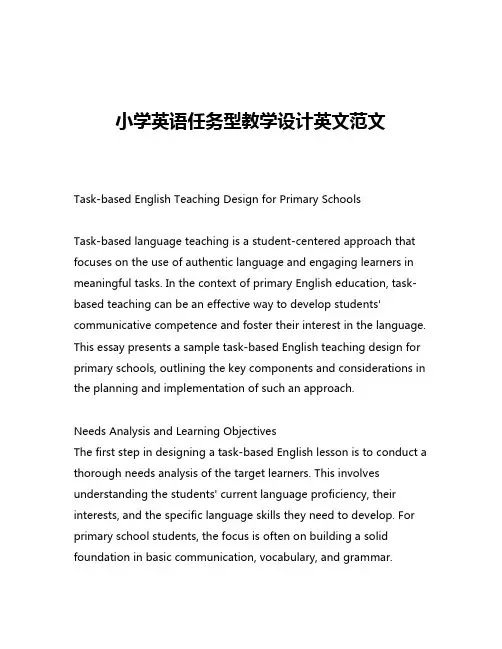
小学英语任务型教学设计英文范文Task-based English Teaching Design for Primary SchoolsTask-based language teaching is a student-centered approach that focuses on the use of authentic language and engaging learners in meaningful tasks. In the context of primary English education, task-based teaching can be an effective way to develop students' communicative competence and foster their interest in the language. This essay presents a sample task-based English teaching design for primary schools, outlining the key components and considerations in the planning and implementation of such an approach.Needs Analysis and Learning ObjectivesThe first step in designing a task-based English lesson is to conduct a thorough needs analysis of the target learners. This involves understanding the students' current language proficiency, their interests, and the specific language skills they need to develop. For primary school students, the focus is often on building a solid foundation in basic communication, vocabulary, and grammar.Based on the needs analysis, the learning objectives for the task-based lesson should be clearly defined. These objectives should be specific, measurable, and aligned with the curriculum standards and the students' developmental stage. For example, the learning objectives for a primary-level task-based lesson might include:1. Students will be able to introduce themselves and exchange basic personal information in simple English.2. Students will be able to follow simple instructions and commands related to classroom activities.3. Students will be able to describe familiar objects and their characteristics using basic vocabulary.Task Selection and DesignThe core of a task-based lesson is the selection and design of the task itself. The task should be meaningful, engaging, and relevant to the students' lives and interests. It should also be appropriately challenging, providing opportunities for students to use their existing language knowledge while also stretching their skills.For primary school students, tasks might involve role-playing scenarios, such as ordering food at a restaurant or making plans with a friend. Other possibilities include information-gap activities, where students work in pairs or groups to share and combine information to complete a task, or problem-solving activities that requirestudents to use their language skills to find a solution.When designing the task, it is important to consider the language input and output required. The task should provide sufficient language support, such as vocabulary lists, sentence starters, or model dialogues, to help students engage with the task successfully. Additionally, the task should be structured in a way that encourages students to use the target language, rather than relying on their native language.Task Cycle and ScaffoldingA well-designed task-based lesson typically follows a three-phase cycle: pre-task, task, and post-task. This cycle allows for scaffolding and support throughout the learning process.In the pre-task phase, the teacher introduces the topic and the task, and activates students' prior knowledge. This might involve presenting vocabulary, grammar, or language functions relevant to the task, or engaging students in a warm-up activity to build interest and motivation.During the task phase, students work individually, in pairs, or in small groups to complete the task. The teacher's role is to facilitate the task, provide guidance and support as needed, and observe the students' language use.The post-task phase is crucial for consolidating learning and providing feedback. This is where the teacher can lead a whole-class discussion, have students share their experiences or solutions, and provide targeted feedback on the language used during the task. The teacher may also use this phase to introduce additional language input or extension activities related to the task.Throughout the task cycle, the teacher should employ various scaffolding techniques to support student learning. This might include modeling language, providing visual aids or graphic organizers, breaking down the task into smaller steps, or offering strategic prompts and questions to guide students' thinking and language production.Assessment and EvaluationAssessing student learning and evaluating the effectiveness of the task-based lesson are essential components of the teaching design. Both formative and summative assessments can be used to measure student progress and inform future instructional decisions.Formative assessment can be integrated throughout the task cycle, allowing the teacher to monitor student understanding and provide immediate feedback. This might involve observing student interactions during the task, providing checklists or rubrics for self-assessment, or conducting informal checks for understanding.Summative assessment, on the other hand, is used to evaluate the students' overall achievement of the learning objectives. This could take the form of a performance-based assessment, where students demonstrate their language skills by completing a task, or a more traditional assessment, such as a written test or an oral presentation.When evaluating the effectiveness of the task-based lesson, the teacher should consider factors such as student engagement, language use, and the achievement of the learning objectives. Feedback from students can also provide valuable insights into the strengths and weaknesses of the lesson design.ConclusionTask-based English teaching can be a highly effective approach for primary school students, as it focuses on developing communicative competence through meaningful and engaging activities. By carefully designing the task, scaffolding the learning process, and incorporating both formative and summative assessments, teachers can create a dynamic and student-centered learning environment that fosters language development and a love for English.。
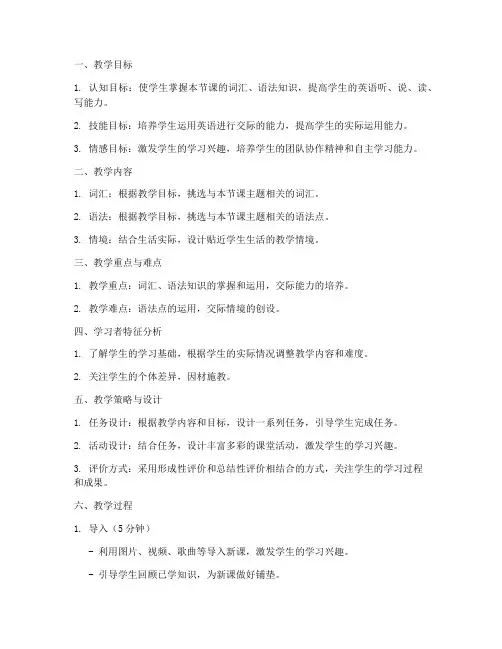
一、教学目标1. 认知目标:使学生掌握本节课的词汇、语法知识,提高学生的英语听、说、读、写能力。
2. 技能目标:培养学生运用英语进行交际的能力,提高学生的实际运用能力。
3. 情感目标:激发学生的学习兴趣,培养学生的团队协作精神和自主学习能力。
二、教学内容1. 词汇:根据教学目标,挑选与本节课主题相关的词汇。
2. 语法:根据教学目标,挑选与本节课主题相关的语法点。
3. 情境:结合生活实际,设计贴近学生生活的教学情境。
三、教学重点与难点1. 教学重点:词汇、语法知识的掌握和运用,交际能力的培养。
2. 教学难点:语法点的运用,交际情境的创设。
四、学习者特征分析1. 了解学生的学习基础,根据学生的实际情况调整教学内容和难度。
2. 关注学生的个体差异,因材施教。
五、教学策略与设计1. 任务设计:根据教学内容和目标,设计一系列任务,引导学生完成任务。
2. 活动设计:结合任务,设计丰富多彩的课堂活动,激发学生的学习兴趣。
3. 评价方式:采用形成性评价和总结性评价相结合的方式,关注学生的学习过程和成果。
六、教学过程1. 导入(5分钟)- 利用图片、视频、歌曲等导入新课,激发学生的学习兴趣。
- 引导学生回顾已学知识,为新课做好铺垫。
2. 任务实施(25分钟)- 任务一:词汇学习- 教师展示词汇卡片,引导学生记忆单词。
- 学生通过小组合作,完成词汇接龙、猜词游戏等活动。
- 任务二:语法学习- 教师讲解语法点,学生进行例句分析。
- 学生通过小组合作,完成语法练习。
- 任务三:交际活动- 教师创设交际情境,引导学生运用所学词汇和语法进行对话。
- 学生进行角色扮演、小组讨论等活动。
3. 总结与反馈(10分钟)- 教师对本节课所学内容进行总结,强调重点和难点。
- 学生进行自我评价和互评,教师给予反馈。
4. 作业布置(5分钟)- 布置课后作业,巩固所学知识。
七、教学评价设计1. 形成性评价:观察学生在课堂上的表现,关注学生的参与度、合作能力和学习能力。
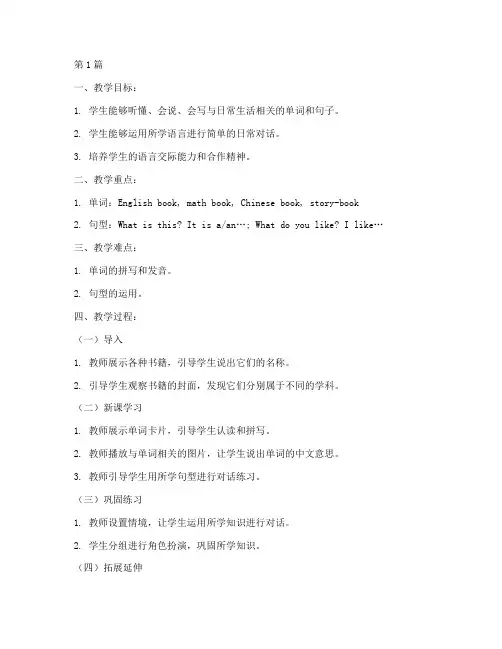
第1篇一、教学目标:1. 学生能够听懂、会说、会写与日常生活相关的单词和句子。
2. 学生能够运用所学语言进行简单的日常对话。
3. 培养学生的语言交际能力和合作精神。
二、教学重点:1. 单词:English book, math book, Chinese book, story-book2. 句型:What is this? It is a/an…; What do you like? I like…三、教学难点:1. 单词的拼写和发音。
2. 句型的运用。
四、教学过程:(一)导入1. 教师展示各种书籍,引导学生说出它们的名称。
2. 引导学生观察书籍的封面,发现它们分别属于不同的学科。
(二)新课学习1. 教师展示单词卡片,引导学生认读和拼写。
2. 教师播放与单词相关的图片,让学生说出单词的中文意思。
3. 教师引导学生用所学句型进行对话练习。
(三)巩固练习1. 教师设置情境,让学生运用所学知识进行对话。
2. 学生分组进行角色扮演,巩固所学知识。
(四)拓展延伸1. 教师播放一段与书籍相关的视频,让学生谈谈自己的看法。
2. 学生分享自己喜欢的书籍,并说明原因。
五、教学评价:1. 课堂参与度:观察学生在课堂上的表现,评价其参与度。
2. 对话能力:评价学生在对话中的语言表达能力和交流能力。
3. 知识掌握情况:通过课堂提问和作业检查,评价学生对知识的掌握程度。
六、教学反思:1. 教师应注重学生的个体差异,因材施教。
2. 教师应创设真实的语言环境,让学生在实际情境中运用所学知识。
3. 教师应鼓励学生积极参与课堂活动,培养学生的合作精神。
第2篇课时:2课时年级:八年级教学目标:1. 学生能够掌握购物场景中的基本词汇和句型。
2. 学生能够运用所学词汇和句型进行简单的购物交流。
3. 培养学生的实际运用能力,提高学生的口语表达能力。
教学重点:1. 掌握水果店购物场景中的基本词汇和句型。
2. 能够运用所学词汇和句型进行简单的购物交流。
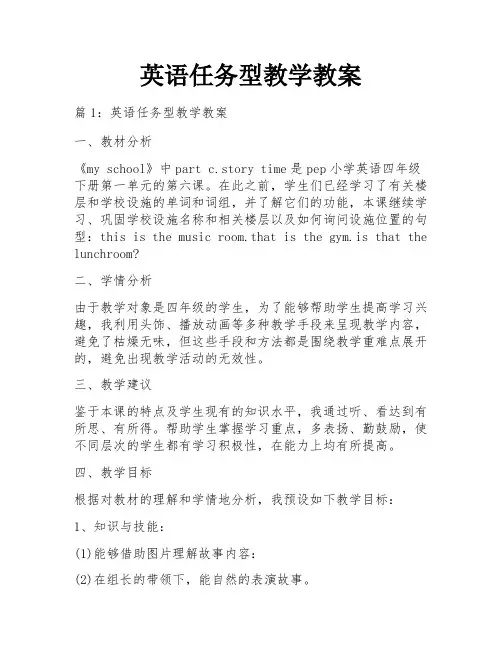
英语任务型教学教案篇1:英语任务型教学教案一、教材分析《my school》中part c.story time是pep小学英语四年级下册第一单元的第六课。
在此之前,学生们已经学习了有关楼层和学校设施的单词和词组,并了解它们的功能,本课继续学习、巩固学校设施名称和相关楼层以及如何询问设施位置的句型:this is the music room.that is the gym.is that the lunchroom?二、学情分析由于教学对象是四年级的学生,为了能够帮助学生提高学习兴趣,我利用头饰、播放动画等多种教学手段来呈现教学内容,避免了枯燥无味,但这些手段和方法都是围绕教学重难点展开的,避免出现教学活动的无效性。
三、教学建议鉴于本课的特点及学生现有的知识水平,我通过听、看达到有所思、有所得。
帮助学生掌握学习重点,多表扬、勤鼓励,使不同层次的学生都有学习积极性,在能力上均有所提高。
四、教学目标根据对教材的理解和学情地分析,我预设如下教学目标:1、知识与技能:(1)能够借助图片理解故事内容:(2)在组长的带领下,能自然的表演故事。
2、过程与方法:任务型教学方法,小组合作、自主学习方法。
3、情感态度与价值观:通过本课的学习,让学生在活动中体验语言知识的活脱、自然;在展示中感受学习成功的乐趣。
五、教学重、难点:教学重点:能够掌握有关学校设施的单词和词组以及询问学校设施的句型:this is the music room.is that the lunch room?教学难点:在实际情景中能够灵活运用stroy time部分的内容并能够大胆创编和表演相关对话。
六、教学策略为了突破这堂课的重、难点,根据小学生好奇、好胜、好动、模仿力强、表现欲旺盛等生理和心理特点,我主要采取了以下教法和学法。
1、直观演示法:利用图片、动画等手段进行直观演示,让学生理解故事内容,激发学生的学习兴趣,活跃课堂气氛,促进学生对知识的掌握。
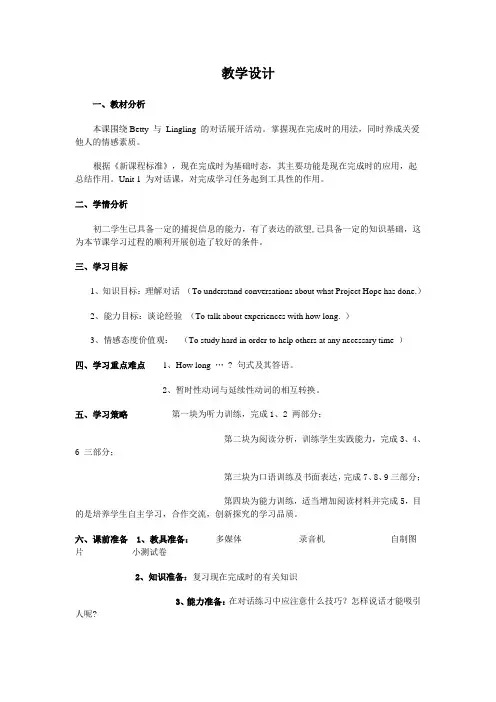
教学设计一、教材分析本课围绕Betty 与Lingling 的对话展开活动。
掌握现在完成时的用法,同时养成关爱他人的情感素质。
根据《新课程标准》,现在完成时为基础时态,其主要功能是现在完成时的应用,起总结作用。
Unit 1 为对话课,对完成学习任务起到工具性的作用。
二、学情分析初二学生已具备一定的捕捉信息的能力,有了表达的欲望,已具备一定的知识基础,这为本节课学习过程的顺利开展创造了较好的条件。
三、学习目标1、知识目标:理解对话(To understand conversations about what Project Hope has done.)2、能力目标:谈论经验(To talk about experiences with how long. )3、情感态度价值观:(To study hard in order to help others at any necessary time )四、学习重点难点1、How long… ? 句式及其答语。
2、暂时性动词与延续性动词的相互转换。
五、学习策略第一块为听力训练,完成1、2 两部分;第二块为阅读分析,训练学生实践能力,完成3、4、6 三部分;第三块为口语训练及书面表达,完成7、8、9三部分;第四块为能力训练,适当增加阅读材料并完成5,目的是培养学生自主学习,合作交流,创新探究的学习品质。
六、课前准备 1、教具准备:多媒体录音机自制图片小测试卷2、知识准备:复习现在完成时的有关知识3、能力准备:在对话练习中应注意什么技巧?怎样说话才能吸引人呢?4、情感准备:做一名光荣的青年志愿者。
七、学习过程(一)情景导入、明确任务学习过程:1、以一曲《Heart of Feeling Grateful》开场,然后转为背景音乐至消失。
2、画外音,用一段深情的英语:It’s such a moving song ,we all know there are still somepoor areas in our country .Thank to the Project Hope, many poor children have achance to go to Hope School .Have you ever heard ahout Hope School? Yes,Infact,since 1989 Project Hope has built schools all over China.Our headteacher has studied the Hope School since three years ago.He said thatwe should get on well with the children from the poor areas.I have beenan English teacher for fifteen years.So I’m looking forward to teachingEnglish in one of the Hope Schools. Do you want to do the same thing whenyou grow up ?…介绍Project Hope.把本课的生词、句式等学习目标用自编的一个短文串起来,以故事的形式展示给学生。
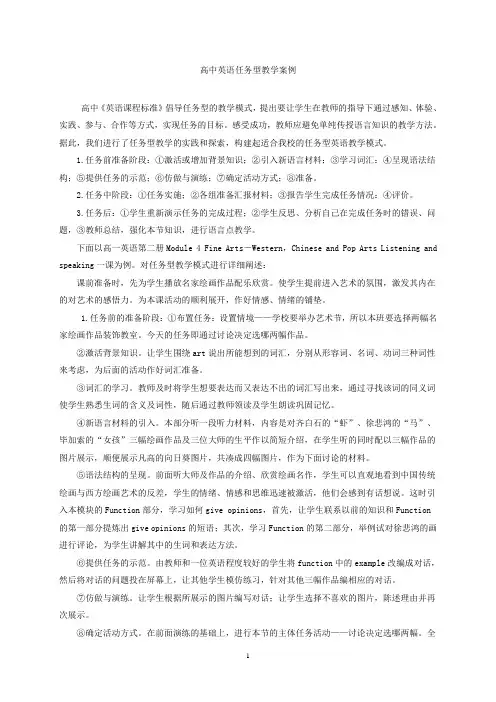
高中英语任务型教学案例高中《英语课程标准》倡导任务型的教学模式,提出要让学生在教师的指导下通过感知、体验、实践、参与、合作等方式,实现任务的目标。
感受成功,教师应避免单纯传授语言知识的教学方法。
据此,我们进行了任务型教学的实践和探索,构建起适合我校的任务型英语教学模式。
1.任务前准备阶段:①激活或增加背景知识;②引入新语言材料;③学习词汇:④呈现语法结构;⑤提供任务的示范;⑥仿做与演练;⑦确定活动方式;⑧准备。
2.任务中阶段:①任务实施;②各组准备汇报材料;③报告学生完成任务情况:④评价。
3.任务后:①学生重新演示任务的完成过程;②学生反思、分析自己在完成任务时的错误、问题,③教师总结,强化本节知识,进行语言点教学。
下面以高一英语第二册Module 4 Fine Arts-Western,Chinese and Pop Arts Listening and speaking一课为例。
对任务型教学模式进行详细阐述:课前准备时,先为学生播放名家绘画作品配乐欣赏。
使学生提前进入艺术的氛围,激发其内在的对艺术的感悟力。
为本课活动的顺利展开,作好情感、情绪的铺垫。
1.任务前的准备阶段:①布置任务:设置情境——学校要举办艺术节,所以本班要选择两幅名家绘画作品装饰教室。
今天的任务即通过讨论决定选哪两幅作品。
②激活背景知识。
让学生围绕art说出所能想到的词汇,分别从形容词、名词、动词三种词性来考虑,为后面的活动作好词汇准备。
③词汇的学习。
教师及时将学生想要表达而又表达不出的词汇写出来,通过寻找该词的同义词使学生熟悉生词的含义及词性,随后通过教师领读及学生朗读巩固记忆。
④新语言材料的引入。
本部分听一段听力材料,内容是对齐白石的“虾”、徐悲鸿的“马”、毕加索的“女孩”三幅绘画作品及三位大师的生平作以简短介绍,在学生听的同时配以三幅作品的图片展示,顺便展示凡高的向日葵图片,共凑成四幅图片,作为下面讨论的材料。
⑤语法结构的呈现。
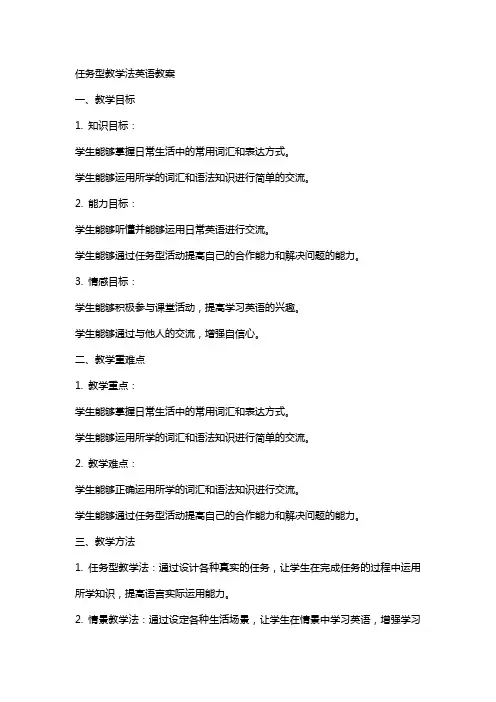
任务型教学法英语教案一、教学目标1. 知识目标:学生能够掌握日常生活中的常用词汇和表达方式。
学生能够运用所学的词汇和语法知识进行简单的交流。
2. 能力目标:学生能够听懂并能够运用日常英语进行交流。
学生能够通过任务型活动提高自己的合作能力和解决问题的能力。
3. 情感目标:学生能够积极参与课堂活动,提高学习英语的兴趣。
学生能够通过与他人的交流,增强自信心。
二、教学重难点1. 教学重点:学生能够掌握日常生活中的常用词汇和表达方式。
学生能够运用所学的词汇和语法知识进行简单的交流。
2. 教学难点:学生能够正确运用所学的词汇和语法知识进行交流。
学生能够通过任务型活动提高自己的合作能力和解决问题的能力。
三、教学方法1. 任务型教学法:通过设计各种真实的任务,让学生在完成任务的过程中运用所学知识,提高语言实际运用能力。
2. 情景教学法:通过设定各种生活场景,让学生在情景中学习英语,增强学习兴趣。
3. 合作学习法:通过小组合作完成任务,培养学生的团队协作能力和解决问题的能力。
四、教学准备1. 教学材料:教材、多媒体课件、任务单、实物等。
2. 教学环境:教室、音响设备、投影仪等。
五、教学过程1. 导入:通过播放一段日常交流的视频,引起学生的兴趣,引出本课的主题。
2. 呈现:教师通过展示实物、图片或多媒体课件,呈现本课的主要词汇和表达方式。
3. practice:学生进行听力练习,听懂并能够模仿所学的词汇和表达方式。
4. 任务型活动:学生分组,根据任务单的要求,完成各种真实的任务,如购物、问路等。
5. 反馈:教师对学生的任务完成情况进行评价,指出学生的优点和需要改进的地方。
6. 总结:教师对本课的主要内容进行总结,强调学生的学习目标。
7. 作业:学生根据本课所学,完成相应的作业,巩固所学知识。
六、教学评价1. 形成性评价:在教学过程中,教师通过观察学生的参与程度、回答问题的情况等,了解学生的学习进度,及时给予鼓励和指导。
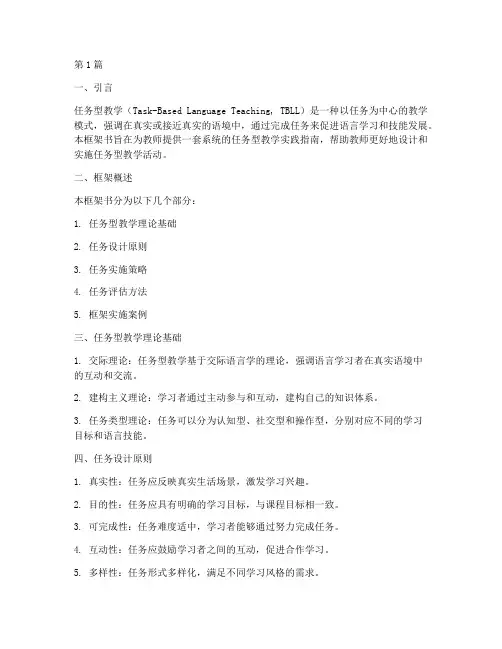
第1篇一、引言任务型教学(Task-Based Language Teaching, TBLL)是一种以任务为中心的教学模式,强调在真实或接近真实的语境中,通过完成任务来促进语言学习和技能发展。
本框架书旨在为教师提供一套系统的任务型教学实践指南,帮助教师更好地设计和实施任务型教学活动。
二、框架概述本框架书分为以下几个部分:1. 任务型教学理论基础2. 任务设计原则3. 任务实施策略4. 任务评估方法5. 框架实施案例三、任务型教学理论基础1. 交际理论:任务型教学基于交际语言学的理论,强调语言学习者在真实语境中的互动和交流。
2. 建构主义理论:学习者通过主动参与和互动,建构自己的知识体系。
3. 任务类型理论:任务可以分为认知型、社交型和操作型,分别对应不同的学习目标和语言技能。
四、任务设计原则1. 真实性:任务应反映真实生活场景,激发学习兴趣。
2. 目的性:任务应具有明确的学习目标,与课程目标相一致。
3. 可完成性:任务难度适中,学习者能够通过努力完成任务。
4. 互动性:任务应鼓励学习者之间的互动,促进合作学习。
5. 多样性:任务形式多样化,满足不同学习风格的需求。
五、任务实施策略1. 任务引入:- 创设情境,激发兴趣。
- 介绍任务背景和目标。
- 明确任务要求。
2. 任务执行:- 分组合作,分工明确。
- 提供必要的资源和支持。
- 监督学习过程,及时调整。
3. 任务展示:- 鼓励学习者展示成果。
- 组织课堂讨论,分享经验。
- 对任务完成情况进行评价。
4. 任务反馈:- 提供即时反馈,帮助学习者改进。
- 引导学习者进行自我评价和同伴评价。
- 总结经验,反思不足。
六、任务评估方法1. 形成性评估:通过观察、访谈、记录等方式,评估学习者在任务过程中的表现。
2. 总结性评估:通过测试、作业等方式,评估学习者在任务完成后的语言知识和技能水平。
3. 自我评估和同伴评估:鼓励学习者进行自我反思和同伴评价,提高自我监控能力。
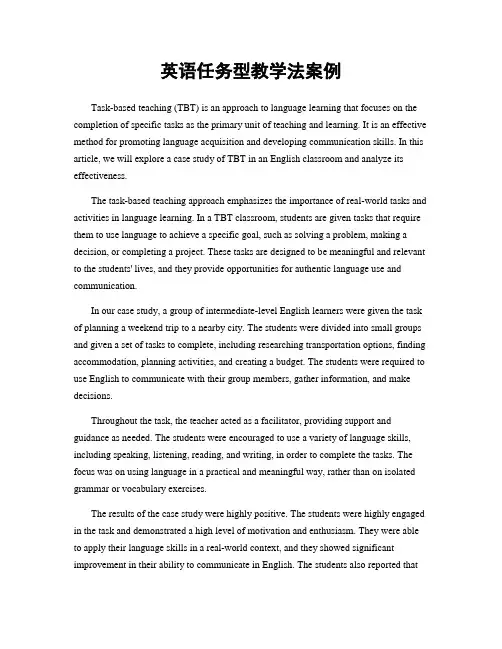
英语任务型教学法案例Task-based teaching (TBT) is an approach to language learning that focuses on the completion of specific tasks as the primary unit of teaching and learning. It is an effective method for promoting language acquisition and developing communication skills. In this article, we will explore a case study of TBT in an English classroom and analyze its effectiveness.The task-based teaching approach emphasizes the importance of real-world tasks and activities in language learning. In a TBT classroom, students are given tasks that require them to use language to achieve a specific goal, such as solving a problem, making a decision, or completing a project. These tasks are designed to be meaningful and relevant to the students' lives, and they provide opportunities for authentic language use and communication.In our case study, a group of intermediate-level English learners were given the task of planning a weekend trip to a nearby city. The students were divided into small groups and given a set of tasks to complete, including researching transportation options, finding accommodation, planning activities, and creating a budget. The students were required to use English to communicate with their group members, gather information, and make decisions.Throughout the task, the teacher acted as a facilitator, providing support and guidance as needed. The students were encouraged to use a variety of language skills, including speaking, listening, reading, and writing, in order to complete the tasks. The focus was on using language in a practical and meaningful way, rather than on isolated grammar or vocabulary exercises.The results of the case study were highly positive. The students were highly engaged in the task and demonstrated a high level of motivation and enthusiasm. They were able to apply their language skills in a real-world context, and they showed significant improvement in their ability to communicate in English. The students also reported thatthey found the task to be enjoyable and rewarding, and they felt a sense of accomplishment upon completing it.Overall, the case study demonstrates the effectiveness of task-based teaching in promoting language acquisition and developing communication skills. By focusing on meaningful tasks and authentic language use, TBT provides a valuable opportunity for students to apply their language skills in a practical and relevant way. It also fosters a sense of autonomy and independence in learning, as students are required to take responsibility for their own language use and learning.In conclusion, task-based teaching is a valuable approach to language learning that can have a significant impact on students' language acquisition and communication skills. By providing opportunities for authentic language use and meaningful tasks, TBT can help students develop the language skills they need to succeed in real-world communication. This case study serves as a compelling example of the effectiveness of TBT in an English classroom, and it highlights the potential benefits of this approach for language learners.。
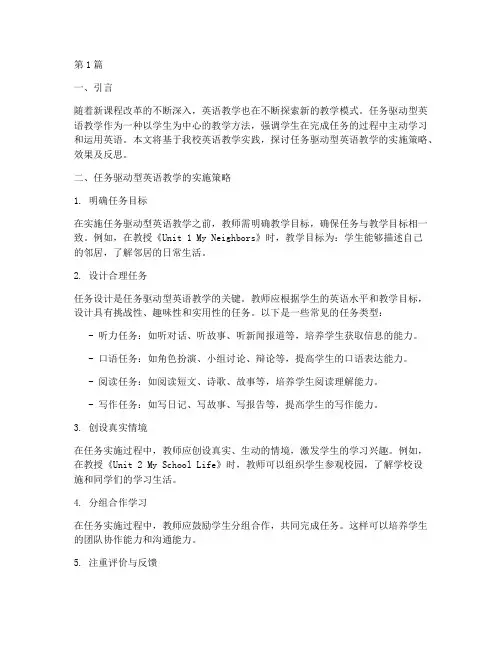
第1篇一、引言随着新课程改革的不断深入,英语教学也在不断探索新的教学模式。
任务驱动型英语教学作为一种以学生为中心的教学方法,强调学生在完成任务的过程中主动学习和运用英语。
本文将基于我校英语教学实践,探讨任务驱动型英语教学的实施策略、效果及反思。
二、任务驱动型英语教学的实施策略1. 明确任务目标在实施任务驱动型英语教学之前,教师需明确教学目标,确保任务与教学目标相一致。
例如,在教授《Unit 1 My Neighbors》时,教学目标为:学生能够描述自己的邻居,了解邻居的日常生活。
2. 设计合理任务任务设计是任务驱动型英语教学的关键。
教师应根据学生的英语水平和教学目标,设计具有挑战性、趣味性和实用性的任务。
以下是一些常见的任务类型:- 听力任务:如听对话、听故事、听新闻报道等,培养学生获取信息的能力。
- 口语任务:如角色扮演、小组讨论、辩论等,提高学生的口语表达能力。
- 阅读任务:如阅读短文、诗歌、故事等,培养学生阅读理解能力。
- 写作任务:如写日记、写故事、写报告等,提高学生的写作能力。
3. 创设真实情境在任务实施过程中,教师应创设真实、生动的情境,激发学生的学习兴趣。
例如,在教授《Unit 2 My School Life》时,教师可以组织学生参观校园,了解学校设施和同学们的学习生活。
4. 分组合作学习在任务实施过程中,教师应鼓励学生分组合作,共同完成任务。
这样可以培养学生的团队协作能力和沟通能力。
5. 注重评价与反馈教师应关注学生在完成任务过程中的表现,及时给予评价和反馈。
评价方式可以包括自评、互评和教师评价,以提高学生的自我评价能力和反思能力。
三、任务驱动型英语教学的效果1. 提高学生英语综合运用能力通过完成任务,学生能够将所学知识运用到实际情境中,提高英语听、说、读、写四项技能的综合运用能力。
2. 激发学生学习兴趣任务驱动型英语教学注重学生的主体地位,让学生在完成任务的过程中体验到学习的乐趣,从而激发学生的学习兴趣。
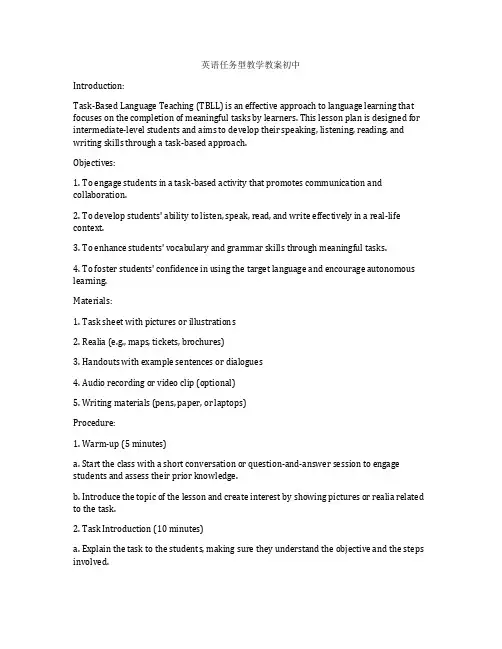
英语任务型教学教案初中Introduction:Task-Based Language Teaching (TBLL) is an effective approach to language learning that focuses on the completion of meaningful tasks by learners. This lesson plan is designed for intermediate-level students and aims to develop their speaking, listening, reading, and writing skills through a task-based approach.Objectives:1. To engage students in a task-based activity that promotes communication and collaboration.2. To develop students' ability to listen, speak, read, and write effectively in a real-life context.3. To enhance students' vocabulary and grammar skills through meaningful tasks.4. To foster students' confidence in using the target language and encourage autonomous learning.Materials:1. Task sheet with pictures or illustrations2. Realia (e.g., maps, tickets, brochures)3. Handouts with example sentences or dialogues4. Audio recording or video clip (optional)5. Writing materials (pens, paper, or laptops)Procedure:1. Warm-up (5 minutes)a. Start the class with a short conversation or question-and-answer session to engage students and assess their prior knowledge.b. Introduce the topic of the lesson and create interest by showing pictures or realia related to the task.2. Task Introduction (10 minutes)a. Explain the task to the students, making sure they understand the objective and the steps involved.b. Provide clear instructions and examples, if necessary, to help students grasp the task requirements.c. Encourage students to ask questions and clarify any doubts they may have.3. Task Execution (25 minutes)a. Divide students into small groups or pairs and provide them with the necessary materials (e.g., task sheet, realia).b. Allow students to work on the task, guiding and supporting them as needed. Encourage active participation and collaboration.c. Monitor students' progress and provide individualized feedback, correcting errors without disrupting the flow of the task.d. If using audio or video materials, play them during this phase to provide additional context or examples.4. Feedback and Error Correction (10 minutes)a. Bring the class together and discuss the results of the task. Encourage students to share their experiences and observations.b. Provide feedback on the task, highlighting successful aspects and areas that need improvement.c. Correct any common errors or misunderstandings, and provide clarification on grammar or vocabulary usage.5. Language Practice (10 minutes)a. Conduct a controlled practice activity, such as a role-play or a gap-fill exercise, to reinforce the target language structures and vocabulary.b. Provide clear instructions and models, if necessary, and allow students to practice in pairs or small groups.c. Encourage students to use the target language actively and correct their errors constructively.6. Summarize and Homework (5 minutes)a. Summarize the main points of the lesson and highlight key vocabulary or grammar points.b. Assign homework that reinforces the skills and knowledge acquired during the lesson, such as a writing assignment or a language-learning task.Conclusion:Task-Based Language Teaching is an engaging and effective approach to language learning that promotes communication, collaboration, and autonomous learning. By following this lesson plan, teachers can create meaningful tasks that develop students' speaking, listening, reading, and writing skills while fostering their confidence in using the target language.。
任务型教学法英语课例英文回答:Task-Based Language Teaching (TBLT) is a teaching method that emphasizes the practical use of language in real-world situations. The primary goal of TBLT is to develop learners' fluency, accuracy, and communicative competence. It achieves this through a focus on meaningful tasks that require learners to use language to complete specific goals or solve problems.TBLT lessons typically involve the following key components:Needs analysis: The teacher identifies the learners' specific language needs and goals.Task design: The teacher designs tasks that are relevant to the learners' needs and that require them to use language in a meaningful way.Task implementation: The learners complete the tasksin groups or individually.Feedback: The teacher provides feedback to thelearners on their performance, focusing on both accuracyand fluency.TBLT offers several advantages over traditionallanguage teaching methods. It helps learners to:Become more fluent and confident in using the language. Develop better communicative skills.Apply language knowledge to real-world situations.Foster collaboration and teamwork.Enhance motivation and engagement.Here is an example of a TBLT lesson plan:Lesson Plan: Ordering Food at a Restaurant.Level: Intermediate English learners.Objectives:Students will be able to order food from a menu.Students will be able to communicate with awaiter/waitress.Students will be able to use appropriate language for ordering food.Materials:Menu.Pen and paper.Procedure:1. Needs analysis: Ask students about their experiences ordering food at restaurants.2. Task design: Divide students into pairs. Give each pair a menu and instruct them to role-play ordering food at a restaurant.3. Task implementation: Students complete the role-play.4. Feedback: Provide feedback to students on their performance, focusing on their use of language and their ability to communicate effectively.Assessment:Students will be assessed on their ability to:Use appropriate language for ordering food.Communicate with a waiter/waitress.Complete the task successfully.中文回答:任务型教学法(TBLT)是一种强调在现实生活中实际运用语言的教学方法。
任务型教学法英语教案第一章:任务型教学法简介1.1 任务型教学法的概念解释任务型教学法的基本概念和原则强调任务型教学法在英语教学中的应用和优势1.2 任务型教学法的目标讨论任务型教学法的主要目标和期望成果强调学生通过参与实际任务来提高语言能力的理念1.3 任务型教学法的实施步骤介绍任务型教学法的基本实施步骤和流程包括任务设计、任务执行和任务反思等环节第二章:任务型教学法的教学设计2.1 任务的设计原则讨论任务设计的基本原则和考虑因素强调任务的实用性和有意义性,以及与学生的兴趣和需求相关性2.2 任务的类型和范例介绍不同类型的任务,并提供具体的范例强调任务的多样性和适应性,以满足不同学生的学习风格和能力水平2.3 任务的教学材料和资源讨论任务教学中所需的教学材料和资源强调利用真实语境和多媒体资源来丰富任务内容和提高学习效果第三章:任务型教学法的课堂实践3.1 任务的实施策略介绍任务实施的基本策略和技巧强调教师在任务过程中的引导和协助作用,以及学生的主体地位3.2 任务型教学法的课堂管理讨论任务型教学法下的课堂管理和组织方法强调建立积极的学习氛围和促进学生合作的重要性3.3 任务型教学法的评估与反馈介绍任务型教学法下的评估方法和策略强调及时反馈和自我评估的重要性,以促进学生的自主学习和改进教学效果第四章:任务型教学法案例分析4.1 案例一:英语口语交流任务分析一个具体的英语口语交流任务案例讨论任务的设计、实施和评估过程,以及学生的参与和反馈情况4.2 案例二:英语阅读理解任务分析一个具体的英语阅读理解任务案例讨论任务的设计、实施和评估过程,以及学生的参与和反馈情况第五章:任务型教学法在中国英语教学中的应用5.1 中国的英语教学背景简要介绍中国英语教学的背景和现状强调任务型教学法在中国英语教学中的重要性和适用性5.2 任务型教学法在中国的实践与挑战讨论任务型教学法在中国英语教学中的实践情况和面临的挑战提出相应的解决方案和建议,以促进任务型教学法在中国的推广和发展第六章:任务型教学法与课程整合6.1 任务型教学法与其他教学法的整合探讨任务型教学法如何与其他教学法如语法教学、词汇教学等相结合强调整合不同教学法以提高英语教学的全面性和有效性6.2 任务型教学法与课程设计的结合讨论如何将任务型教学法融入到整个课程设计中强调制定明确的学习目标、内容组织和教学评估的重要性第七章:任务型教学法在特定场景中的应用7.1 任务型教学法在商务英语教学中的应用分析任务型教学法在商务英语教学中的应用和案例强调模拟商务场景和实际商务任务的重要性7.2 任务型教学法在旅游英语教学中的应用分析任务型教学法在旅游英语教学中的应用和案例强调模拟旅游场景和实际旅游任务的重要性第八章:任务型教学法的教师培训与专业发展8.1 任务型教学法的教师培训需求讨论任务型教学法对教师培训的需求和重要性强调教师在任务型教学法中的角色和能力要求8.2 任务型教学法的教师专业发展路径探讨教师如何通过参与研讨会、工作坊和教学研究等活动来提升任务型教学法的专业能力第九章:任务型教学法的教学案例研究9.1 任务型教学法的案例研究方法介绍进行任务型教学法案例研究的方法和步骤强调选择合适的研究方法和数据收集、分析的重要性9.2 任务型教学法的案例研究实例提供一个具体的任务型教学法案例研究实例分析案例研究的发现和结论,以及对教学实践的启示第十章:任务型教学法的未来发展方向10.1 任务型教学法的创新与拓展探讨任务型教学法的创新方法和拓展方向强调利用技术和多媒体资源,以及跨学科合作的机会10.2 任务型教学法的国际发展趋势分析任务型教学法在国际英语教学领域的最新发展和趋势强调任务型教学法在全球化教育背景下的重要性和适用性重点和难点解析重点环节1:任务型教学法的概念和原则需要重点关注任务型教学法的核心理念和原则,包括学习者的主体性、任务的实用性、合作的互动性和语言的真实性。
英语任务型教学教案英语的根底就是从单词起步到句子,所谓的句子练习,它包含了你对单词的认知,包含了你对语法学问点的认知,包含了你口语力量的认知,句子练习可以让你知道,用英语思维说话是什么样的。
下面是我给大家整理的英语任务型教学教案5篇,期望对大家能有所挂念! 英语任务型教学教案1课时教学内容:Storytime教学目标:能初步听懂、会说、会读单词lovely, nine, eight, our, five, six, seven, ten.2. 能在情境中感知如何谈论年龄,能初步听懂、会说、会读句型日常交际用语:How old are you I’m … . How lovely! Here you are.教学重点、难点能在情境中感知如何谈论年龄,能初步听懂、会说、会读句型日常交际用语:How old are you I’m … . How lovely! Here you are.教具、学具预备:单词卡片,PPT教学过程:step 1. Greeting and warm upT: …, please close the door.…, please close the window.T: Good morning/afternoon, boys and girls.Ss: Good morning/afternoon, Miss Cui.T: …, can you count from one to ten 同学试着说。
What’s this number (呈现数字8)Ss: Eight. (T教eight,以同样的方法教nine,ten)Step 2.Presentation and practice .T:(出示Mike, Helen, Tim的图片)Look, Helen is Mike’s brother. Mike is nine. And how old are youSs: I’m eight/nine /ten .新授句型,引导同学问答。
tblt教学法教案模板简介tblt教学法(Task-Based Language Teaching,任务型教学法)是一种以任务为核心的外语教学方法。
它强调学生通过完成真实的语言任务来学习语言,注重培养学生的语言运用能力和交际能力。
教师在tblt教学法下扮演着引导者和促进者的角色,倡导以学生为中心的教学方式。
教学目标•学生能够理解并能正确使用与生活和学习相关的基础词汇和句型;•学生能够通过给出的信息完成特定的任务,并能够自信地讲述完成任务的过程;•学生能够在交流中灵活运用所学知识和技能。
教学内容本教案的教学内容为描述和谈论日常活动和生活习惯的基础词汇和句型。
教学步骤导入(5分钟)教师可以通过一段简短的视频或图片展示来引起学生的兴趣,激发学生对话题的兴趣,例如展示一个有关日常生活的短视频。
任务介绍(10分钟)教师向学生介绍本次任务:学生将分成小组,在限定的时间内,撰写一篇关于自己日常活动习惯的短文,并准备一段口头介绍。
教师解释任务要求和评估标准,并鼓励学生参考课堂上所学的词汇和句型。
学习任务(20分钟)教师分发学习资源,包括相关词汇和句型的表格、示例句子、参考资料等。
学生在小组内合作讨论和完成任务所需的前期准备工作,如列出日常活动清单、选择相关的词汇和句型等。
教师在学生合作的过程中提供必要的指导和帮助。
任务实施(30分钟)学生在小组内开始撰写关于自己日常活动习惯的短文,并准备好口头介绍。
教师在此过程中巡视各小组,提供反馈和帮助。
学生可以利用课堂上学到的词汇和句型,互相帮助和交流,完善自己的短文。
分享与总结(15分钟)每个小组选择一位代表,口头介绍他们的短文和相关的日常活动习惯。
教师鼓励其他学生提问和互动。
教师对每个小组的表现进行评价,同时总结今天的教学内容和收获。
教学评估教师可以根据学生短文的准确性、流畅性和语法正确性来评估学生的口头表达能力。
此外,教师还可以观察学生在小组合作中的参与度和互动情况,评估学生的合作能力和交际能力的发展情况。
外国语学院任务型教学法英语教案(课程论文)学号:******T241专业:学科教育(英语)学员姓名:曹丹任课教员:苏勇任务型英语教学教案曹丹201421T241年级:增盛镇中学八年级4班课题名称:Unit2 Colors and Moods教材选自:人教版新目标英语一、教学案例的设计与分析1.教材分析本单元的中心话题是“颜色与心情”,学习不同种类的颜色及其对人情绪的影响。
其中重点介绍了色彩与情绪的关系,而本单元阅读部分内容正是围绕这一中心话题展开的。
阅读部分向学生介绍了谈论颜色有助于引出关于情绪和情感的内容。
鼓励学生运用本单元的知识开始思考他们的情绪和情感。
2.学情分析:本课授课对象是级增盛镇中学八年级4班学生,该年龄阶段的学生具有旺盛的求知欲和高涨的学习热情,所以教师一开始就应该使学生的学习成为一种令人愉快,充满趣味,富有吸引力的活动。
同时绝大部分学生对英语学习具有一定的兴趣,但由于学习能力较低,学习方法不佳,学习缺少主动性,这些都给平时的教学带来较大的困难。
同时,该年龄段的学生具有感知能力强的特点,通过教师有效的教学及恰当的学习指导,加上他们对英语学习应给予的更多的关注,教学的基本要求是可以达到的。
3.教学目标设计1)基本知识目标:学习和掌握阅读部分所涉及的新单词和词组,尤其是一些习惯用语的表达方式及用法方面的固定搭配。
2)能力智力目标:进一步训练学生的自我阅读能力,并要求能够在快速阅读后领会主要句子的意思。
3)德育情感目标:鼓励学生运用文章中所了解色彩和情绪的关系的知识思考他们的情绪和情感,并讨论在自己或别人伤心的时候,该如何帮助自己或别人。
4.教学重点与难点1)怎样来正确使用与课文有关的重要词汇短语?2)对文章的听读理解能力及获取具体信息的能力3)对文章快速阅读的能力及阅读对写作的迁移能力5.教学方法和教学工具任务教学法(Task-Based Language Teaching),多媒体教室,录音机,教材6.教学时间一课时教学(共45分钟)7.教学形式:Task-based learning, activity-based teaching (class work; individual work; pair work; group work)二、课堂教学程序的设计Step1. Warming up任务设计(1)do a survey about your favorite color(2)show up(设计目的:在正式阅读文章前,给学生分组布置任务,通过五环及福娃,要求前后四名学生为一组共同讨论各自喜爱的不同颜色的福娃及其原因,体现团队合作精神。
tblt教学法教案模板教案概述本教案以tblt教学法(Task-Based Language Teaching,任务型教学法)为基础,旨在帮助教师设计一个具有结构清晰、内容丰富、教学效果显著的教案。
教学目标•学生能够理解和运用特定主题中的关键词汇和基本语法结构。
•学生能够通过实际任务进行真实语言的运用。
•学生能够展示他们在特定主题中所学到的语言知识和技能。
教学材料•一份包含主题相关词汇和句型的课本或教学材料。
•一系列图片、图表或其他视觉辅助工具。
•学生用纸和笔。
教学步骤1.任务引入(Task Introduction)引入任务的目的是激发学生的学习兴趣,并为后续的学习内容做好铺垫。
可以使用引人注目的图片、视频片段或者故事等方式引起学生的兴趣。
同时,引入任务的过程中可以使用一些简单的问题或猜测游戏来渗透学生的想象力和好奇心。
2.任务明确(Task Clarification)在明确任务之前,教师应该向学生提供足够的背景信息,让他们理解本任务的目标和涉及的主题。
然后引导学生讨论任务的具体要求,激发学生的思考和合作。
3.任务准备(Task Preparation)学生在进行任务前需要对相关语言知识和技能进行预习和准备,以保证他们在任务中的表现和交流的流畅性。
教师可以提供一些词汇和语法练习,让学生通过模仿和运用巩固所学内容。
4.任务实施(Task Performance)学生根据任务要求进行实际交流和表演。
教师可以把学生分成小组,让他们在小组内进行讨论和合作,同时教师应该扮演一个引导者和指导者的角色,鼓励学生积极参与任务,提供必要的帮助和反馈。
5.任务反思(Task Reflection)在任务完成后,教师带领学生一起回顾任务的过程和结果。
学生可以讨论他们在任务中遇到的困难和解决方法,同时也可以分享他们的成果和体会。
教师应该鼓励学生对任务进行评价和反思,提出改进的建议以及对语言学习的认识。
教学评估•在任务实施中,教师可以观察学生的表现并给予口头或书面反馈。
教学设计
一、教材分析
本课围绕Betty 与Lingling 的对话展开活动。
掌握现在完成时的用法,同时养成关爱他人的情感素质。
根据《新课程标准》,现在完成时为基础时态,其主要功能是现在完成时的应用,起总结作用。
Unit 1 为对话课,对完成学习任务起到工具性的作用。
二、学情分析
初二学生已具备一定的捕捉信息的能力,有了表达的欲望,已具备一定的知识基础,这为本节课学习过程的顺利开展创造了较好的条件。
三、学习目标
1、知识目标:理解对话(To understand conversations about what Project Hope has done.)
2、能力目标:谈论经验(To talk about experiences with how long. )
3、情感态度价值观:(To study hard in order to help others at any necessary time )
四、学习重点难点1、How long… ? 句式及其答语。
2、暂时性动词与延续性动词的相互转换。
五、学习策略第一块为听力训练,完成1、2 两部分;
第二块为阅读分析,训练学生实践能力,完成3、4、6 三部分;
第三块为口语训练及书面表达,完成7、8、9三部分;
第四块为能力训练,适当增加阅读材料并完成5,目的是培养学生自主学习,合作交流,创新探究的学习品质。
六、课前准备 1、教具准备:多媒体录音机自制图片小测试卷
2、知识准备:复习现在完成时的有关知识
3、能力准备:在对话练习中应注意什么技巧?怎样说话才能吸引人呢?
4、情感准备:做一名光荣的青年志愿者。
七、学习过程
(一)情景导入、明确任务
学习过程:1、以一曲《Heart of Feeling Grateful》开场,然后转为背景音乐至消失。
2、画外音,用一段深情的英语:It’s such a moving song ,we all know there are still some
poor areas in our country .Thank to the Project Hope, many poor children have a
chance to go to Hope School .Have you ever heard ahout Hope School? Yes,In
fact,since 1989 Project Hope has built schools all over China.Our head
teacher has studied the Hope School since three years ago.He said that
we should get on well with the children from the poor areas.I have been
an English teacher for fifteen years.So I’m looking forward to teaching
English in one of the Hope Schools. Do you want to do the same thing when
you grow up ?…介绍Project Hope.把本课的生词、句式等学习目标用自编的
一个短文串起来,以故事的形式展示给学生。
运用多媒体,幻灯机,图片等展示
生词。
板书学习目标,感知How long … ?及其答语。
设计目的:激发学生善心,以感恩的心态主动学习。
开课即抓住学生思绪,掀起
第一次学习高潮。
运用头脑风暴集中识词,为以下学习扫清障碍。
(二)分组合作、展现提升
1、听力训练(完成1、2)
学习过程:⑴准备:学生自读题目⑵实施:播放听力内容两遍
⑶检查:小组交流检查⑷核对:分组以问答形式给出答案
设计目的:培养听力能力与技巧,进一步认识How long句型。
初步形成合作交流,为学习对话做好过渡。
2、操练对话(完成
3、
4、6)
环节过渡:Well done.We’ve known Ms James quite well .Oh, listen! Who are Betty and Lingling talking about ? How long has Lingling known her ?
学习过程:⑴听录音,回答以上两题(感知对话)
⑵速读,完成4 (扫清对话前的知识障碍)
1自主完成2小组交流3全班检查4教师点拨
⑶跟读,模仿标准音(做好语音准备)
⑷分角色训练,合作学习,鼓励学生开口,教师巡回指导
⑸课堂展示:情景再现,给课文动画配音
⑹能力提升:精读,完成6 ,归纳连词,because ,so ; although ,but , yet .⑺分组归纳,展示交流。
探究暂时性动词与延续性动词的相互转换。
例句:The film has begun, it has been on for ten minutes now .
I have had this book since I bought it.小组竞赛:引导学生说出更多例句。
设计目的:本环节为重要内容,突出重点,解决难点,有的放矢,做好中考链接。
引入竞争机制,激发学生学习热情,增强学习信心。
新颖的形式掀起第二次
学习高潮,要求尽量背诵,可进行必要提示,以尊重学生个性,彰显人性化
教学。
(三)穿插巩固,创新探究环节过渡:We know a lot about Sally. Now let’s make a project.
学习过程:1、新闻采访,重点在于内化How long 句型,回应课题
2、拓展阅读,⑴配乐朗诵:《I Want to Be a Student》⑵电影片段:《No One Less》
设计目的:扩展学生视野,启迪心智,掀起第三次学习高潮。
进一步加强合作学习,培养学生口头及书面表达能力,完成信息输出功能。
(四)课堂总结,达标测评总结本节重点考点,给出一些小测试题,当堂完成并评价。
设计目的:梳理知识使之系统条理化,养成良好学习习惯。
(五)渗透情感,布置作业
We are moved by the students who study hard from the poor area , so we should treasure our happy life and study harder . Would you like to know more about Project Hope ?Go on line and find out some information about it.
播放歌曲《One Word One Dream》,课堂结束。
设计目的:进一步增强学生的民族意识,学会关爱他人,学会感恩。
五、课后反思(一)情景导入,激活课堂。
这是语言课开口说的前提。